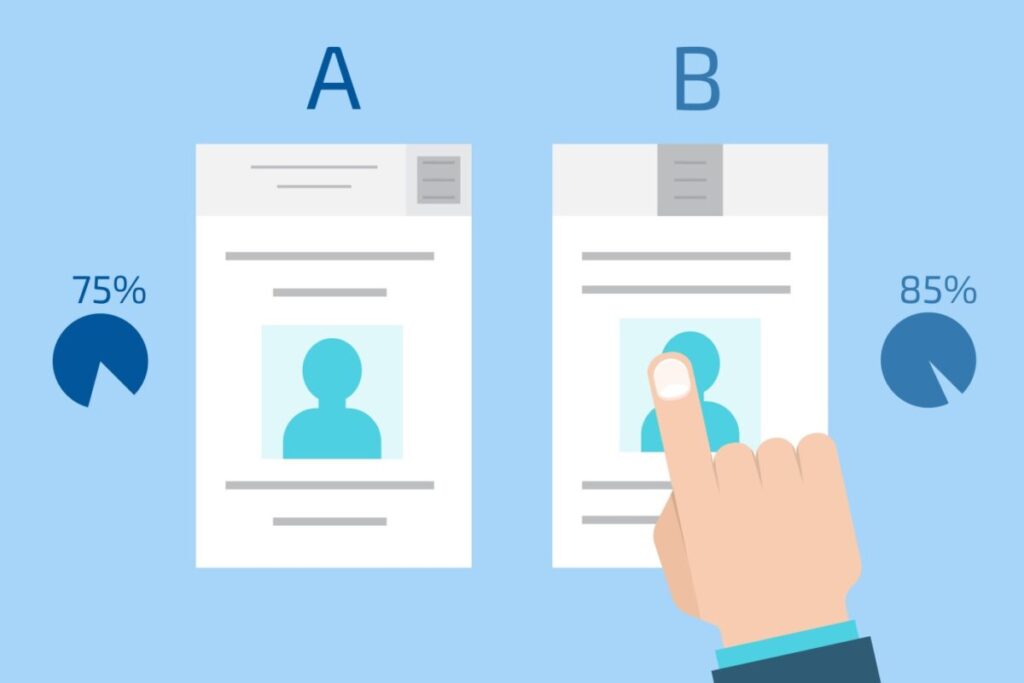Introduction
A/B testing is a “performance tuning” process in email marketing where two versions of an email are compared to identify which one performs better. This technique involves the creation of two distinct versions of an email. Each version is slightly or substantially different, depending on the variables you choose to test, such as email design,subject lines, call-to-action placement, or even send times.
Once these versions are ready, they are sent to different subsets of your email list. Each email plays its part, engaging with recipients and prompting responses.
A Comprehensive Guide to A/B Testing in Email Marketing
- Define Your Objective: Clearly outline the goal of your A/B test. Common objectives include increasing open rates, click-through rates, conversion rates, or engagement. Having a clear goal will help you design effective tests.
- Choose Elements to Test: Decide on the specific elements you want to test. Common elements include subject lines, email copy, images, calls-to-action, sender names, and sending times. Start with one element at a time to isolate variables and accurately measure their impact.
- Create Variations: Develop two versions of your email campaign (A and B) with a single differing element. For example, if testing subject lines, keep all other elements identical between the two versions.
- Split Your Audience: Divide your email list randomly into two segments. One segment receives version A, and the other receives version B. Ensure the segments are similar in terms of demographics and behavior in order to obtain meaningful results.
- Test Size and Duration: Determine the percentage of your audience that will receive the test emails (typically 10-20%). Also, decide how long the test will run to gather sufficient data. Ensure the duration is long enough to capture different time zones and days of the week.
- Measure Key Metrics: Track relevant metrics based on your objective. Common metrics include open rates, click-through rates, conversion rates, and revenue generated. Use email marketing software or analytics tools to collect and analyze the data.
- Statistical Significance: Ensure that your results are statistically significant to draw meaningful conclusions. Tools like statistical calculators can help determine if the observed differences are likely due to chance or if they are statistically significant.
- Implement the Winner: Once the test is complete, compare the performance of versions A and B. Implement the version that outperformed the other for the remaining portion of your audience.
- Iterate and Test Again: Use the insights gained from each test to inform future campaigns. Continuously refine your email marketing strategy based on what works best for your audience.
- Document and Share Findings: Keep a record of your A/B tests, including the elements tested, results, and any insights gained. Share these findings with your team to enhance collective knowledge and improve future campaigns.
Why does A/B Testing Matter?
A/B testing is not just a “routine activity” but an essential tool for making informed decisions about your email marketing strategy.The significance of split testing lies in its ability to uncover the most effective way to communicate with your audience, driving engagement and fostering desired actions. By allowing marketers to compare two different email versions of an email and recognize which one performs better, A/B testing eliminates guesswork and paves the way for data-driven decisions that can drastically enhance your email campaigns’ open rates, click-through rates, and conversion rates.

Furthermore, the insights gained from A/B testing extend beyond immediate email campaign optimization. They provide knowledge about your audience’s preferences and behaviors, informing your broader marketing strategy. With each test, you’re not merely fine-tuning an email but build a more compelling and effective marketing message.
A/B Testing Idea Examples
The beauty of A/B testing lies in its adaptability. From email subject lines to design elements, you can test many variables in order to optimize your email campaigns:
1.Testing Subject Lines is a must since it’s the first thing a recipient sees, making it a critical factor in determining whether your email gets opened. Testing different subject lines can help you understand what kind of language, tone, and even email copy length resonate most with your audience. For example, you can compare subject line length or question-based subject lines to statement-based ones.
2. Comparing Email Layouts and Designs of your emails can significantly impact their readability and engagement. Through A/B testing, you can determine which templates and visuals work best for your audience. This could involve testing different formats (plain text email vs. HTML email), layouts (single column vs. multiple columns), and visual elements (images vs. gifs vs. emojis).
3. Evaluating the Call-To-Action Button is the gateway to conversion. By testing different versions of your CTA button – such as its color, size, text, and placement – you can optimize it to drive maximum clicks.
4. Experimenting with Personalization can be a game-changer in email marketing . Whether it’s using the subscriber’s name in the subject line or tailoring the email content to their preferences, A/B testing can provide insights on how to personalize your emails for better engagement effectively.
Whatever idea you come up with, the ultimate goal remains the same: to continuously optimize your email design and content for enhanced engagement and a reduced risk of unsubscribes.

Conclusion
In conclusion, A/B testing is an indispensable tool for email marketing, providing invaluable insights that can help optimize your email campaigns for better performance. By consistently testing different elements, learning from the A/B test results, and implementing the winning versions, you can significantly enhance your email marketing efforts, resulting in higher open rates, click-through rates (CTR), and conversions.
Remember, A/B testing is not a one-time affair; it’s a continuous cycle of improvement. Each test provides a nugget of knowledge that contributes to the refinement of your strategies. It’s about staying agile, responsive, and always in tune with the evolving preferences of your audience.








